Stop Mattress Sliding: Easy Tips for a Stable Sleep In 2024
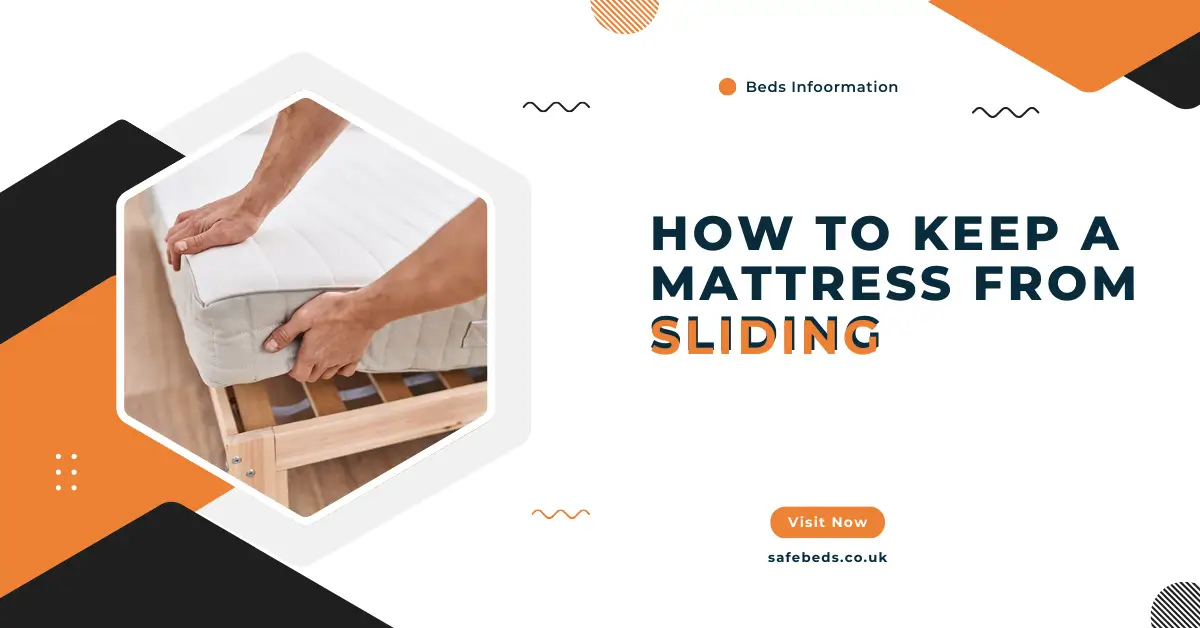
When it’s time to rest and unwind, a sliding mattress can quickly disrupt the relaxation of your bedroom haven. It’s especially annoying when you’re getting into bed or adjusting sleeping positions, only to feel your mattress shifting out of place.
Fortunately, you can tackle this frustrating issue with a few straightforward fixes. Solutions like placing a rubber mat beneath the mattress, using non-slip pads, or opting for a sturdier bed frame can work wonders to prevent your mattress from moving.
Reclaim your bedroom as the ideal place for rest with a few easy adjustments and enjoy a mattress that stays put, keeping your nights undisturbed and relaxing. Why does a mattress slide? There are several potential reasons for a sliding mattress, and a close inspection of your bed can help pinpoint the root cause.
Contents
- 1 Lack of Friction
- 1.1 The Mattress is Smaller Than the Bed Base
- 1.2 Mattress Weight
- 1.3 Lack of Support
- 1.4 Bed Frame Style
- 1.5 Your Mattress is Past Its Best
- 1.6 How to stop a mattress from sliding
- 1.7 >> Our Quality Beds and Frames Explore Now
- 1.8 Can you put a mattress on the floor to stop it sliding?
- 1.9 How to stop a mattress from sliding on an adjustable base
- 1.10 Complete Mattress Buying Guide | How to Choose A Mattress
- 1.11 Conclusion
- 1.12 FAQs: How to Keep a Mattress from Sliding
- 1.12.1 1. How can I prevent my mattress from sliding?
- 1.12.2 2. What is the best solution for stopping my mattress from moving?
- 1.12.3 3. Do mattress toppers help prevent mattress sliding?
- 1.12.4 4. Can I use Velcro to stop my mattress from sliding?
- 1.12.5 5. Does a mattress protector help with sliding?
- 1.12.6 6. Why is my mattress sliding even with a non-slip pad?
- 1.12.7 7. What is the best non-slip mat for a mattress?
- 1.12.8 8. Can a mattress slip on a box spring?
- 1.12.9 9. How do I stop a memory foam mattress from sliding?
- 1.12.10 10. Do bed frames affect mattress sliding?
Lack of Friction
A lack of friction is a common cause of mattress movement, especially if the bed base has a smoother surface or the mattress itself is made from low-traction materials, like quilted or single-sided types.
Without adequate traction, the mattress can become prone to sliding, particularly with movement. Placing a non-slip mat between the mattress and the base can help secure it, creating the friction needed to stay in place.
The Mattress is Smaller Than the Bed Base
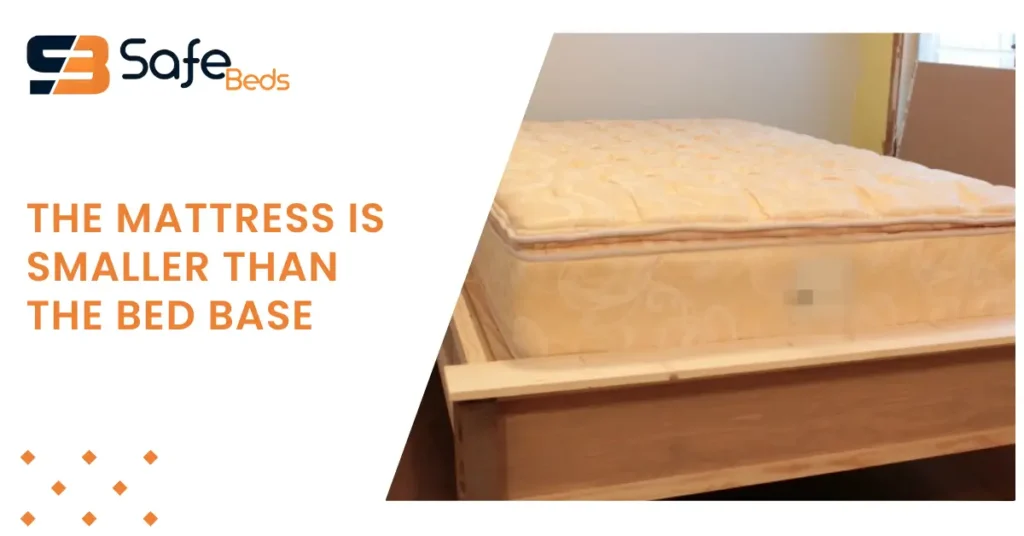
When your mattress is not the exact size as the bed base, especially if it’s slightly smaller, it creates a gap that increases sliding. For example, adjustable beds often require a mattress that is 200 cm long, but many standard single mattresses are only 190 cm, leaving room at the bottom for movement. Even a minor gap can lead to shifting, so choosing a compatible size is essential.
Mattress Weight
The weight of your mattress affects its stability. Heavier mattresses, often made with higher-quality materials, have more resistance against movement than lighter ones, like those made from synthetic materials. Larger, heavier mattresses tend to stay in place, while smaller or lighter mattresses are more likely to slide around with regular use.
Lack of Support
An uneven or unsupportive bed base may cause the mattress to shift. For example, slats that are far apart may allow the mattress to sag, leading to extra movement. Sprung slats, which are typically smoother than solid slats, may allow for more sliding, whereas solid slats provide more traction. Ensuring your bed base offers full support without dips or gaps will keep the mattress more stable.
Bed Frame Style
The design of your bed frame also plays a role in whether a mattress stays put. Frames with rails, a footboard, or an enclosed frame offer better support than metal or slatted frames, where the mattress isn’t enclosed and can move more easily. Ottoman and other slatted frames are particularly prone to sliding.
Your Mattress is Past Its Best
An older mattress may be more susceptible to sliding, especially if it’s no longer supportive or has collected dust, debris, sweat, and bodily fluids over time, which can make the surface slippery. Regular cleaning can help reduce sliding by keeping the surface clean and free from particles that cause slipperiness.
How to stop a mattress from sliding
There are several ways to stop your mattress from sliding.
Use a Breathable Blanket or Duvet
Placing a breathable blanket or duvet under your mattress adds just enough traction to keep it from sliding. This cost-effective solution creates friction between the underside of the mattress and the bed base, helping it stay in place.
Use a Mattress Pad
For those using a slatted bed frame, adding a mattress pad is a smart move. It can shield your mattress from splinters and indentations, making it less likely to slide, while providing a bit of extra comfort.
Keep Your Bed Clean
A clean bed not only supports a healthy environment but also keeps your mattress steady. Regular cleaning removes dust and debris that can make the mattress surfaces slippery. A quality mattress protector can also act as a barrier against stains and spillages, preserving the condition of both your bed and mattress.
Try Velcro Strips
Velcro strips can work wonders for securing a single-sided mattress. Applied to the non-sleeping underside, these strips offer effective anti-slide power. However, avoid using them with removable or stretch covers, as these materials may snag or wear out.
Mattress Grippers
Mattress grippers are specially designed, slip-resistant pads that fit between the mattress and bed base. They’re easy to trim to size and provide enough grip to hold your mattress firmly in place without being visible.
Change Your Bed
An old, worn-out bed base can cause your mattress to slide, so if yours isn’t flat and stable, consider a replacement. Divans are particularly good options, often featuring an anti-slip surface that adds extra grip.
Invest in a Bigger Bed
If partner disturbance often shifts your mattress, a bigger bed might be the solution. The added space minimizes movement, improves sleep quality, and keeps your mattress more stable, with less risk of tossing and turning during the night.
Attach a Headboard
Attaching a headboard or footboard to your bed can further prevent your mattress from shifting or sliding. Just make sure it’s securely fastened, as this adds stability at the edge of your bed, reducing unwanted movement.
>> Our Quality Beds and Frames Explore Now
-
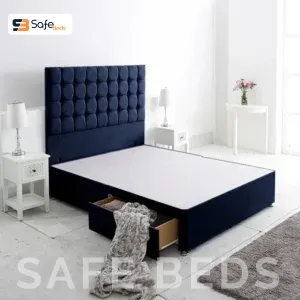 Tulip Divan Base and 54″ Headboard Set Buy With DiscountFrom: £220.00
Tulip Divan Base and 54″ Headboard Set Buy With DiscountFrom: £220.00 -
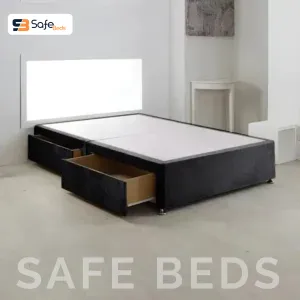 Royal Platform Top Divan Bed Base – Reinforced SupportFrom: £185.00
Royal Platform Top Divan Bed Base – Reinforced SupportFrom: £185.00 -
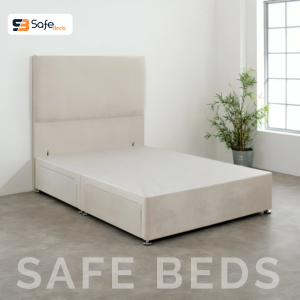 Buy Classic Platform Top Divan Bed Base – Firm SupportFrom: £120.00
Buy Classic Platform Top Divan Bed Base – Firm SupportFrom: £120.00 -
Product on sale
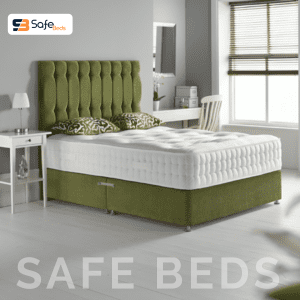 Luxury Redefined: Virginia 2 Stud Divan Bed – SafebedsFrom:
Luxury Redefined: Virginia 2 Stud Divan Bed – SafebedsFrom:£370.00£299.00 -
Product on sale
 Luxury Meets Function: Golden Skyline Storage Bed In 2024Original price was: £459.00.£349.00Current price is: £349.00.
Luxury Meets Function: Golden Skyline Storage Bed In 2024Original price was: £459.00.£349.00Current price is: £349.00. -
Product on sale
 The Princess Signature Bed: Luxurious Upholstered FrameFrom:
The Princess Signature Bed: Luxurious Upholstered FrameFrom:£420.00£339.00
Can you put a mattress on the floor to stop it sliding?
While placing your mattress on the floor might seem like a quick fix to stop it from sliding, it’s not recommended. This can expose your mattress to cold air, pests, and dust, which are not ideal for your sleep environment.
Additionally, the lack of ventilation underneath the mattress can lead to mould and mildew, causing long-term damage. A proper bed base is essential to keep your mattress in good condition and ensure a more comfortable and hygienic sleep.
How to stop a mattress from sliding on an adjustable base
If your mattress is slipping on an adjustable base, the issue could be a missing retainer bar at the foot of the base. The retainer bar helps prevent the mattress from moving during use.
If it’s missing, you can easily purchase a replacement from most manufacturers or retailers. Attaching it is usually a straightforward process. Ensuring the retainer bar is in place will help secure the mattress and stop it from sliding on your adjustable base.
Complete Mattress Buying Guide | How to Choose A Mattress
Conclusion
To prevent your mattress from sliding, a few simple and effective solutions can make a significant difference. It’s essential to first identify the cause of the movement, whether it’s due to lack of friction, a smaller mattress than the bed base, or an uneven bed frame.
Simple fixes, such as adding a breathable blanket, using mattress grippers, or ensuring your bed base is flat and stable, can significantly reduce sliding. If your mattress is older or worn out, a new bed base or a larger bed may be necessary for better support.
Consider also attaching a headboard or using Velcro strips for a more secure fit. These fixes, along with regular cleaning to remove dust and debris, will help keep your mattress in place and improve the overall sleep quality by providing a steady, supportive foundation.
FAQs: How to Keep a Mattress from Sliding
1. How can I prevent my mattress from sliding?
To keep your mattress from sliding, start by using a non-slip mattress pad or a grip mat. These products are designed to add friction between the mattress and the bed frame, helping to keep the mattress in place. Another option is to use corner straps or anti-slip tape, which are easy to apply and keep your mattress from shifting during the night.
2. What is the best solution for stopping my mattress from moving?
The best solution to stop a mattress from moving is to use a combination of non-slip items. A non-slip mattress pad or rug grip mat is an affordable and effective option. For added stability, consider using corner straps that secure the mattress to the bed frame, preventing any unwanted shifting, especially on slatted bed frames.
3. Do mattress toppers help prevent mattress sliding?
Yes, mattress toppers can help prevent sliding by providing extra grip. A topper made from a thicker or more textured material can provide more friction, reducing the likelihood of your mattress shifting. However, pairing the topper with a non-slip mattress pad or anti-slip mat ensures better results.
4. Can I use Velcro to stop my mattress from sliding?
Velcro strips can be a great solution for stopping a mattress from sliding, especially if your bed frame doesn’t have a solid surface. Simply attach the Velcro strips to the bed frame and the mattress to hold them together. This solution is discreet, easy to apply, and effective for preventing movement.
5. Does a mattress protector help with sliding?
Yes, a mattress protector can help prevent your mattress from sliding, especially if it has a non-slip backing. Many mattress protectors come with a rubberized or silicone coating on the underside that grips the bed frame or box spring, keeping your mattress stable throughout the night.
6. Why is my mattress sliding even with a non-slip pad?
If your mattress is still sliding despite using a non-slip pad, it could be due to the type of bed frame you have. Slatted bed frames or those with a smooth surface can make it harder to maintain grip. In this case, consider adding additional anti-slip materials, such as non-slip strips or corner straps, or even switching to a more textured surface like a solid foundation or platform bed.
7. What is the best non-slip mat for a mattress?
The best non-slip mat for a mattress is one made from rubber or silicone, as these materials provide excellent grip. Look for mats that are large enough to cover the full surface area of the bed and have a high-quality, durable texture that will stay in place without slipping or bunching.
8. Can a mattress slip on a box spring?
Yes, a mattress can slip on a box spring, especially if the box spring has a smooth surface or is not designed to hold the mattress securely. To prevent this, use a non-slip mattress pad or a rug grip mat on top of the box spring. This will help anchor the mattress in place and prevent sliding.
9. How do I stop a memory foam mattress from sliding?
To stop a memory foam mattress from sliding, start by using a non-slip mattress pad or a grip mat specifically designed for foam mattresses. Memory foam is naturally slippery on smooth surfaces, so adding a texture or friction point will keep it from moving. Also, using corner straps or placing the mattress on a solid platform bed can further secure it in place.
10. Do bed frames affect mattress sliding?
Yes, the type of bed frame can greatly affect whether your mattress slides. Bed frames with slats or a smooth surface can allow the mattress to shift. To prevent sliding, opt for a solid platform bed or use anti-slip materials like a non-slip pad, grip mat, or corner straps to secure the mattress. A sturdy, well-fitted frame reduces the chance of movement.
